
Bobby Vinton – “Blue Velvet”: A Romantic Classic Wrapped in Nostalgia and Elegance
Bobby Vinton’s “Blue Velvet” is one of the most iconic love ballads of the 1960s, celebrated for its lush orchestration, dreamy vocals, and timeless appeal. Originally written by Bernie Wayne and Lee Morris in 1950, the song had been recorded by several artists before Vinton’s version, but it was his 1963 rendition that became definitive. Vinton’s “Blue Velvet” topped the Billboard Hot 100 for three weeks and reached No. 1 on the Adult Contemporary chart, cementing its place in music history as a classic that continues to captivate audiences with its elegance and charm.
The song opens with a sweeping orchestral introduction, featuring soft strings and a delicate piano melody that immediately set a romantic, wistful tone. This lush arrangement serves as the perfect backdrop for Vinton’s silky vocals, creating a sound that feels intimate yet grand. The orchestration is a hallmark of early 1960s pop, blending traditional balladry with a rich, cinematic quality that evokes feelings of nostalgia.
Lyrically, “Blue Velvet” is a poetic reflection on a love that lingers in memory, symbolized by the softness and richness of blue velvet. Lines like “She wore blue velvet / Bluer than velvet was the night” paint vivid, almost tactile imagery that captures the intensity and beauty of a past romance. The lyrics balance simplicity and sophistication, creating an emotional resonance that feels timeless. The velvet metaphor, with its connotations of luxury, elegance, and depth, adds an air of mystery and longing to the song.
The chorus, “And I still can see blue velvet through my tears,” is both haunting and tender, encapsulating the bittersweet nature of reminiscing about a lost love. This refrain, with its gentle repetition, becomes the emotional centerpiece of the song, underscoring its themes of memory and yearning. The simplicity of the chorus allows the listener to fully immerse themselves in the sentiment, making it universally relatable.
Bobby Vinton’s vocal performance is the heart of “Blue Velvet”. His smooth, velvety voice is perfectly suited to the song’s romantic mood, delivering each line with tenderness and emotional depth. Vinton’s ability to convey both joy and melancholy gives the song its unique character, making the listener feel the weight of his longing while also appreciating the beauty of the memories he’s reliving. His controlled phrasing and natural warmth elevate the song, turning it into a timeless masterpiece.
The musical arrangement, produced by Bob Morgan, is a study in elegance and restraint. The string section provides a lush, flowing backdrop, while the piano adds a touch of intimacy. The subtle use of backing vocals enhances the song’s dreamy atmosphere without overpowering the lead vocal. The arrangement’s focus on simplicity and beauty ensures that the emotional core of the song remains front and center.
Since its release, “Blue Velvet” has been celebrated as one of the most romantic songs of its time, often associated with nostalgia and the idealized love of a bygone era. Its enduring appeal has been reinforced by its use in films and pop culture, most notably in David Lynch’s 1986 film Blue Velvet, where it played a pivotal role in establishing the movie’s mysterious and unsettling tone. This association has given the song a dual identity, as both a symbol of romantic longing and a piece of haunting cultural commentary.
In the decades since its release, “Blue Velvet” has been covered by numerous artists and remains a favorite for weddings, anniversaries, and romantic occasions. Its universal themes of love, memory, and longing continue to resonate with listeners, ensuring its place as a cornerstone of American pop music.
In the end, “Blue Velvet” is more than just a love song—it’s a timeless ode to the power of memory and the emotions tied to cherished moments. Bobby Vinton’s heartfelt performance, combined with the song’s lush orchestration and evocative lyrics, creates a track that transcends its era and continues to enchant new generations of listeners. For fans of classic ballads and anyone who has ever felt the bittersweet pull of nostalgia, “Blue Velvet” remains a musical treasure.